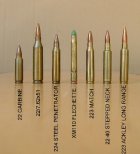A couple of shooters have asked why I did not include the 223 Remington in my series on Competition Cartridges. First of all, the 223 never really caught on as a competitive cartridge. Flanked by the 222 on one side and the 222 Magnum on the other doesn’t leave much room for improvement and shooters, for some reason, love to "improve" a cartridge rather than shooting one right out of the box. Second, since my series was also intended to explore the history of the cartridges, the convoluted development of the 223 was hardly the type of thing non-collectors would be interested in. But, I’ll try and cover it as best I can and even show a few of the prototype cartridges that led to its adoption.
The concept of a small caliber high velocity military cartridge is anything but new, going back more than 100 years. The venerable 30-06 is but one of many in the lineup. ,Yes, the ‘06 was considered both small caliber and high velocity in its day) But at the end of World War II, development of a light, small caliber infantry weapon accelerated to a frenzy level not only in the United States but many other countries as well. Every caliber from 17 to 30 was loaded in case sizes ranging from the 30 Carbine to the 30-06. Unusual and bizarre bullet ideas, such as multiple projectiles, steel penetrators, and flechettes,darts) were tested, apparently without limit or restraint. But in the late 1950s two reasonable ideas finally came together for the first time - an extended length 222 Remington case and the Armalite AR 15 rifle. The race ended in 1964 with the adoption of the M16 Rifle and the 5.56 x 45mm cartridge.,I have greatly simplified the history for your benefit. It was anything but simple.)
Shortly thereafter, Remington introduced the commercial version of the cartridge, the 223 Remington. Benchrest shooters didn’t exactly rush to embrace the new cartridge. A few tried it exactly as sold by Remington, some improved it by blowing out the shoulder to 40 and 45 degrees, even fewer necked it up to .243,6x45). But none of these could do anything that the 222 and 222 Magnum based cartridges weren’t already doing. The introduction of the PPC and BR lines in the 1970s pretty well sounded the death knell for all three.
The military 5.56 x 45mm is still used in competition where it is one of only three cartridges permitted in “as issued†service rifle matches, the 7.62x51 and 30-06 being the other two. Every once in a while a long-range shooter will forget what history has tried to teach him and will try to resurrect the .223 with the high BC 80 and 90 grain bullets. But except for military rifle and exclusive AR-15 competition it is seldom seen on the firing line today.
Pictured are four of the prototypes and three of the competition cartridges from my collection.
The concept of a small caliber high velocity military cartridge is anything but new, going back more than 100 years. The venerable 30-06 is but one of many in the lineup. ,Yes, the ‘06 was considered both small caliber and high velocity in its day) But at the end of World War II, development of a light, small caliber infantry weapon accelerated to a frenzy level not only in the United States but many other countries as well. Every caliber from 17 to 30 was loaded in case sizes ranging from the 30 Carbine to the 30-06. Unusual and bizarre bullet ideas, such as multiple projectiles, steel penetrators, and flechettes,darts) were tested, apparently without limit or restraint. But in the late 1950s two reasonable ideas finally came together for the first time - an extended length 222 Remington case and the Armalite AR 15 rifle. The race ended in 1964 with the adoption of the M16 Rifle and the 5.56 x 45mm cartridge.,I have greatly simplified the history for your benefit. It was anything but simple.)
Shortly thereafter, Remington introduced the commercial version of the cartridge, the 223 Remington. Benchrest shooters didn’t exactly rush to embrace the new cartridge. A few tried it exactly as sold by Remington, some improved it by blowing out the shoulder to 40 and 45 degrees, even fewer necked it up to .243,6x45). But none of these could do anything that the 222 and 222 Magnum based cartridges weren’t already doing. The introduction of the PPC and BR lines in the 1970s pretty well sounded the death knell for all three.
The military 5.56 x 45mm is still used in competition where it is one of only three cartridges permitted in “as issued†service rifle matches, the 7.62x51 and 30-06 being the other two. Every once in a while a long-range shooter will forget what history has tried to teach him and will try to resurrect the .223 with the high BC 80 and 90 grain bullets. But except for military rifle and exclusive AR-15 competition it is seldom seen on the firing line today.
Pictured are four of the prototypes and three of the competition cartridges from my collection.











